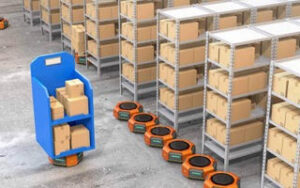 Welcome back! As we wrap up the series on warehouse robotics, where we understand the term and the different types of warehouse robots in the previous two blogs, today, we shall list down the many benefits of putting robots to use in warehouses. Let’s begin.
Welcome back! As we wrap up the series on warehouse robotics, where we understand the term and the different types of warehouse robots in the previous two blogs, today, we shall list down the many benefits of putting robots to use in warehouses. Let’s begin.
Industrial productivity has come a long way since the 18th century. Not only have industries revamped themselves in terms of the total output, but the resources expended to produce a single unit of any finished product have also dramatically come down. Novel technological innovations have helped companies achieve both of these objectives simultaneously.
Robotics is one such technology. Unerring accuracy, uninterrupted efficiency, and top-notch productivity can be considered the obvious advantages of robots over human labor. But is that it? Are these the reasons why many companies are investing in robots in their warehouses? Let’s take a look at all the various benefits that robots offer.
1. Ability to invest incrementally
First and foremost, you don’t need to shell out company funds over a premium, state-of-the-art robotic installation. Since robotics can be deployed in the warehouse on an incremental basis, you ideally should install only those robotic capabilities that will serve your current need. In case demand for your product ratchets up in the market, you can always scale up and deploy robots in a modular fashion on your factory floor. The great news is that you won’t have to re-arrange your factory landscape drastically to accommodate new robotic facilities. Displacing a few shelves and hangars would suffice.
2. Quick implementation
In case you run a large-scale factory, it is quite possible to integrate robotics into your assembly line within three weeks. Compared to laying the foundation of a goods-to-person modality, which might take up a year or more, escalating to robotic solutions is fast-paced.
3. Robots can be calibrated
No business ever runs on an even and steady note at all times.  Output levels are often determined by fluctuations in demand and disruptions in the value and volume of raw materials. In such a case, a large workforce of on-roll employees can send the expenses side of your firm’s income statement shooting up. This makes for a double whammy. Not only are employees being a burden on your income, but your revenue will also be plummeting thanks to falling demand.
Output levels are often determined by fluctuations in demand and disruptions in the value and volume of raw materials. In such a case, a large workforce of on-roll employees can send the expenses side of your firm’s income statement shooting up. This makes for a double whammy. Not only are employees being a burden on your income, but your revenue will also be plummeting thanks to falling demand.
It is here that robots can be the ace up your sleeve. Robots can be calibrated to move as per your undulating productivity goals. During lean seasons, many of them can be retired, and during peak seasons, all of them can be put to use for hours without any need for them to rest and recuperate.
4. Better safety standards
So many companies fork out millions and millions in employee compensation due to disability caused by accidents during everyday work. These compensations are hefty and large enough to dent the company’s profitability. Other ancillary costs such as providing lifetime livelihood to the employee and his family are also shouldered by the company.
All these hassles are now a thing of the past for companies with robots handling complex operations on the factory floor. Robots are automated and can work tirelessly for days on end without causing disruptions in the supply chain. Putting robots to work in your industry can help you escape punishing industrial and labor tribunal compensations orders.
5. Increased productivity
Humans, by nature, are prone to errors. A larger number of employees in the factory without AI or robotic supervision leads to greater installation errors, quality defects, low output, or higher output, with a sizable percentage of that higher output being sub-standard goods.
Robots do not suffer from any of these flaws. Companies globally are stepping up and employing robots to perform tedious, mind-numbing tasks while leaving human prowess for functions where a sense of quality discernment or subjective assessment is required.
The final word
The market for global warehouse robotics is set to quadruple by 2030 to $ 16,000 million from its prior position of $4,400 million in 2020, as per a research report by Allied Market Research.
Over the coming decades, productivity will break through the earlier records, translating into economy and efficiency for the consumer. At the same time, it will build fortunes and a massive dividend yield for businessmen and investors.
Stay tuned to our Knowledge Corner as we continue to bring exciting topics related to technology in our blog series.


